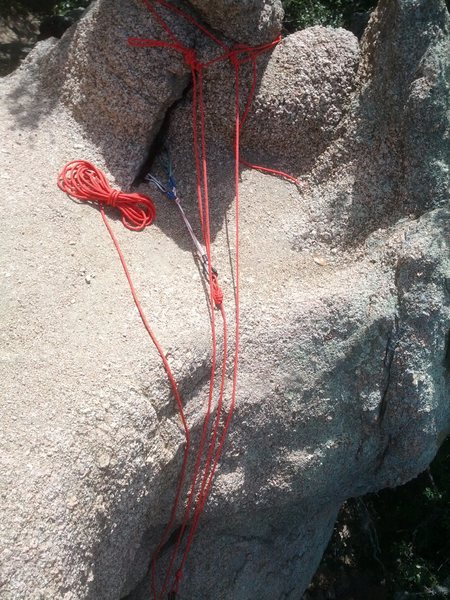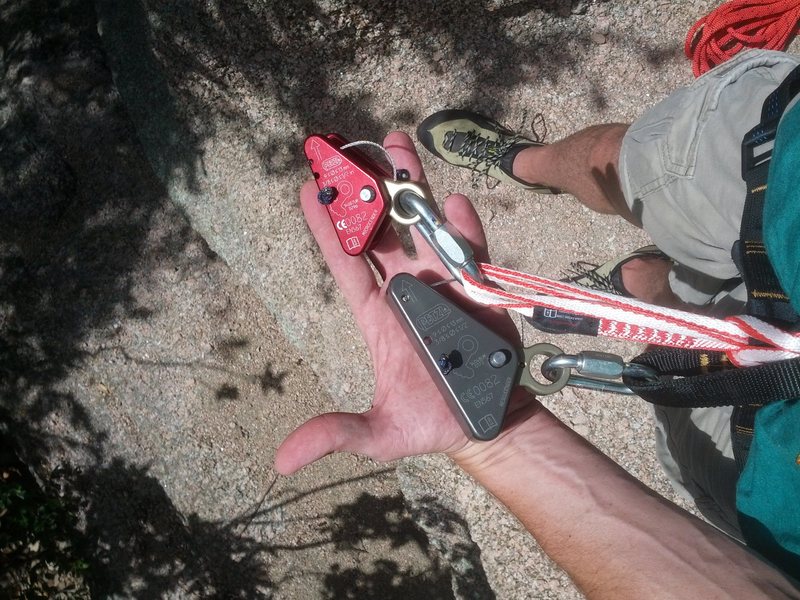Top Rope Solo - Rope set up
|
|
I also have had success with a single rope system for TR solo. Cinch above a minitrax, no back up knots. At the top, just lock the minitrax open and lower on the cinch, quick and easy to run laps on any route up to a full 70 meters. |
|
|
Capt. Impatient wrote:I never understood how the two rope system can in to play for top rope soloing. One single line down from the anchors,(cut a 70 meter rope in half and just use one strand this cuts about 7 lbs from your pack weight too) one solo device, and tie back up knot in your line as you go. The knots will not go through your device. ( I tie overhands on a bight one handed with either hand and then put a carbiner in the loop for giggles. I do have "an oh shit kit" on my harness loops so if I do get into trouble which has happened before. Climbing an over hang and peeled off. Dangling in the air I had to figure something out. Good thing my chalk bag belt it a 5mm rope made a prussik and was able to unload my device and lower.- most folks TR solo climbs that are less than half a rope length ... so you can use 2 strands easily - the knots may not go through the device, but the ascender can be damaged by the fall ... and on toothed ascenders may strip the rope should the cam re-engage during the fall ... you may well need to be able to escape with a damaged rope and without the ascender petzl Petzl - with a second ascender you dont realistically risk any serious fall ... with a single ascender it depends WHERE you tie yr backup knots ... many folks tie em every say 20 feet or even more ... remember with rope stretch you can still have a knot save you but smack a ledge or feature - 2 strands add redundancy to the line ... its always possible for a fix line to rub and get damaged/cut, especially dynamic ones - self rescue is greatly simplified with 2 strands heres a recent accident by a local climber A few locals have already heard I had a "ushba style" ( Grandwall brand, aluminum) rope grab fail on me on a fixed rope while solo freeclimbing. I decked from fifty feet, could easily have died or worse but basically walked away with a fractured vertebrae with no deficits. I know this type of rope grab device is widely used by many exactly as I used it, one rope, one device. It travels well and by all appearance, testing and prolonged usage seemed entirely reliable, effective and idiot proof. Apparently not, is all I can say at this point. As for my event all I can say is that as my body fell, so fell the "ushba" without any aparent body weight activation of the device, required to force the cam against the rope. It was a clean fall, no interference from clothing, hands, pendulums or anything else out of the ordinary, just like a few hundred over a year or two of use. Set up was tested effective just prior and the rope was weighted with about 2 killos at the bottom. One thing I'm suspicious of is the nine mill I was using, being "skinny". device is "rated" (stamped) as good for 8 mil to 12 mil. Prior, no discernable difference was noted in using 9 mil or 10 mil. in terms of ability to grab rope. Generally speaking, I'm stumped as to exactly what happened but I suspect it was a "1in 100,000" sort of event, meaning once every blue moon, you can expect this thing will fail. That is how I'm looking at it and considering what widespread usage these things get for soloing, I suggest everyone should reconsider single device / no back up usage as is commonly practiced. Personaly, I'm going back to the drawing board ( once I'm out of crutches that is) and will be going back to my rescuecender or something else but i will also be building in some redundency or backup some how, hopefully avoiding the hated backup knots or second rope but not ruling it out. I'm all ears if other people have their own tales of failure or have good systems to recommend. My most significant error was relying on a single critical element, then getting sucked into complacency by an illusion of reliability by repeated successes, forgetting one critical thing: It dosn't matter how many hundreds of sucesses you have, it only matters if you have a single failure! squamishclimbing.com/squami… |
|
|
The Blueprint Part Dank wrote:I think the Kong Duck is the best top rope solo decide out thereThaks for sharing this. I have been using the microscenders/rescuescenders for this purpose, The duck looks like it would also allow for rope slippage as well and is slightly more compact. Agree 100% with bearbreader above and having 2 strands available, Never been a fan of using toothed progress capture in a system where slack or slippage might occur. |
|
|
I use a microcender for that reason and have felt a little weary about using a toothed device as my back up. anyone have any qualms about using a second non-toothed device for the back up on a single line set up?Assuming a halved line purely for escaping the system. |
|
|
Right and thanks for the petzl photos. I also dont understand why people still go with the traxion and mini traxion. it is right there from petzl that the fall force can be between 4kn and 8kn. and what is the mini traxion highest breaking strengh? 4kn... |
|
|
I have been trying out this Kong Duck and it has at least jumped in front of my old Gibbs in terms of a nice piece of solo kit...Good call Dank Blueprints |
|
|
taipan jam wrote:I have been trying out this Kong Duck and it has at least jumped in front of my old Gibbs in terms of a nice piece of solo kit...Good call Dank Blueprints Rick Blair wrote: Thaks for sharing this. I have been using the microscenders/rescuescenders for this purpose, The duck looks like it would also allow for rope slippage as well and is slightly more compact. Agree 100% with bearbreader above and having 2 strands available, Never been a fan of using toothed progress capture in a system where slack or slippage might occur.The Kong Duck is my favorite new piece of gear in years. Since ya'll have one now, another thing I find it really useful for is for safer simul-climbing. If you're on terrain that's on the borderline of being too difficult to simul, you can have the leader climb to the end of the rope, stop and place a bomber piece (or pair of pieces)and then clip the Duck to the piece of pro, then thread the rope through so it will allow upward progress and lock off any downward pull. That way if the second falls, he/she won't pull the leader off, and in contrast to the Tibloc (which I've seen certain alpinist use for this purpose), the Duck doesn't have any teeth to shred you rope's sheath. |
|
|
Capt. Impatient wrote:Right and thanks for the petzl photos. I also dont understand why people still go with the traxion and mini traxion. it is right there from petzl that the fall force can be between 4kn and 8kn. and what is the mini traxion highest breaking strengh? 4kn...True, but keep in mind that your primary device won't see forces nearly this high, provided that your system is set up and working well. The real concern is that if the primary fails, the backup device could see factor 2 forces under worst-case conditions. Even in this scenario, Petzl suggests the real problem isn't failure of the traxion, but rope sheath damage, which is why they recommend using a toothed device as primary and a non-toothed as backup. My own setup consists of two micro traxions on separate lines, which works beautifully for my purposes, but I've been thinking about moving to an alternate backup due to the reason given above. |
|
|
I took off work July 8th and the rest of the week to do a solo trip to my climbing area. All of the climbing I did was solo, so I came prepared to solo top rope. It seemed I had E Rock all to myself, for I did not see any other climbers this trip. |
|
|
Why quick links and not lockers? |
|
|
Rick Blair, |
|
|
Jake Jones wrote:I did this with a Basic at my chest and trailing a Cinch on a short sling. Two separate lines, both fixed at the top, both weighted at the bottom. Rope feeds seamlessly through both devices. You're backed up. If you want to re-work a section, move the Cinch up, engage it, weight it, disengage the teeth on your other device, quickly rap down, re-engage, and work.How do you move the Cinch up? If you're hanging from the Basic then the rope above the Basic will be weighted, do you hang from protection to unweight the rope and then transfer the Cinch above the Basic to rap to the part you want to repeat? Would this work with a Grigri (have never used a Cinch)? Thanks! |

 Continue with onX Maps
Continue with onX Maps Continue with Facebook
Continue with Facebook


























